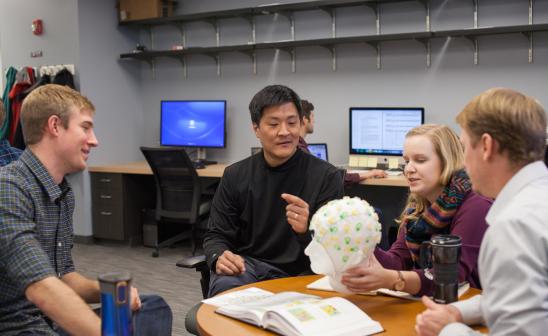Psychology’s Ed Awh offers new insights into how short-term memory works

Short-term memory is the gateway to information storage in the human brain, and Ed Awh has spent his career trying to figure out how exactly it works. Awh’s research has focused on the use of magnetic resonance imaging (MRI) and electroencephalograms (EEG) to track activity in the brain as it relates to memory function.
“Short-term memory is the system that helps us keep a very limited amount of information active or in mind,” he says. If researchers can understand why people capture certain information in short-term memory, and why some individuals have a higher or lower capacity for working memory, it will provide valuable insights into how the brain supports intelligent behaviors.
Awh got his first taste of brain imaging in 1990 while working as a research tech at the University of Chicago hospital’s Franklin McClean Positron Emission Tomography Research Center. He caught the eye of a professor from the University of Michigan who was working on one of the first cognitive neuroimaging grants funded by the Office of Naval Research, and his career took off from there.
“It was a point in the field where cognitive neuroscience was just emerging,” he says. Most experts in the field had been trained as behavioral cognitive psychologists, and so the opportunity to combine cognitive models with measurements of human brain activity was still quite novel, though in time the research proved valuable. “Neuroimaging and neuroscience methods became quite prominent in the field over the next decade,” he says. “I was lucky to be on the ground floor of that.”
Mapping memories
Awh studied short-term working memory and attention using both neuroimaging and behavioral measures while completing his Ph.D. at the University of Michigan, and later in his post-doctoral work at the University of California San Diego. He spent 16 years teaching at the University of Oregon before he joined the University of Chicago faculty in 2015 as a professor in the Department of Psychology, The Institute for Mind and Biology, and the Grossman Institute for Neuroscience, Quantitative Biology and Human Behavior.
Awh has continued his research on memory and attention in his lab in the Institute for Mind and Biology, which he co-directs with Professor Ed Vogel. He and his team use psychophysics, EEG, and functional MRI to learn about the neural mechanisms underlying the basic cognitive processes of short-term memory and the relationship between these processes and other cognitive functions.
Using EEGs, his team is mapping activity in the brain via electrodes placed on the scalp. In one approach, they have discovered that the distribution of activity in the alpha-band frequency band allows them to decode locations that are held in mind by participants. The work, which is supported by a National Institute of Mental Health grant, expands on prior studies demonstrating that alpha-band activity is directly related to visual attention, and the new technique provides a near real-time measurement of spatial representations in the human brain.
It all ties back to understanding why we remember what we remember, and how we use that information in everyday life. He notes that even the simplest tasks, like going upstairs to get your keys, can only be accomplished if an individual can voluntarily hold that plan in their mind. “Attention defines what is likely to be captured in short-term memory,” he says. “It is the foundation of goal-directed behaviors.”
There’s an app for that
Awh sees many real-world applications for this research, including understanding the disruptive impact of depression and attention deficit disorder, treating traumatic brain injuries, and measuring memory declines as an early indicator of dementia. “If we can recognize that the working memory system is disrupted, it may be possible to provide treatment sooner,” he says.
His team is currently working on a mobile app to measure memory capacity. They hope to use it to capture longitudinal data on very large populations to track the trajectory of memory loss. The initial prototype was developed by Chicago’s own app development team, and the lab is now working with a commercial development firm to expand its capacity. “We hope to get a million or more people, and to take a deep dive into a massive dataset,” he says. They plan to begin testing the app in a few months.
The app development team is just one of many cross-collaborations Awh has experienced in his three years in UChicago. He often finds himself talking with university psychologists, neurobiologists, and physicians on wide range of research topics. “It’s an interesting way to get a fresh perspective on the kinds of problems we are all dealing with,” he says.
He also appreciates the enthusiasm and knowledge of his students. Last year, Awh had more than 15 undergrads working in his lab under doctoral and post-doc students, helping to develop new programs, run tests, and gather data. He looks forward to working with more graduate and undergraduate students in the coming school year as he continues his work. “Their desire to have an impact on the research and the quality of their skills are rare in a typical college population,” he notes. “I’ve been very impressed.”